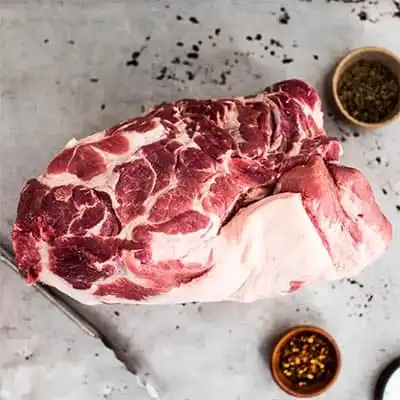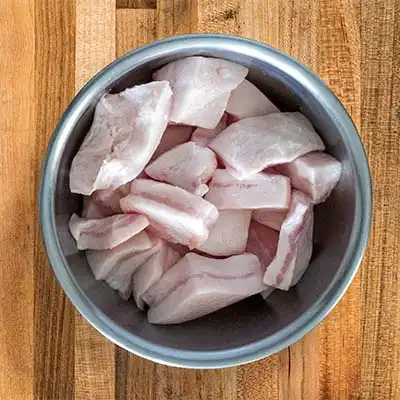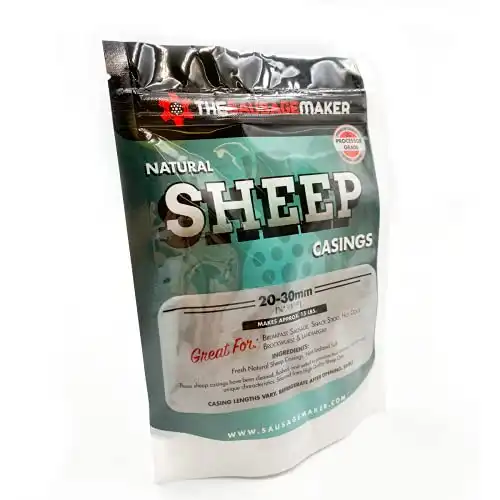How to Make Smoked Hot Dogs From Scratch

There are not many things more quintessential to a summer cookout than a good hot dog.
Alas, hot dogs have become a casingless shadow of their former selves, lacking in both flavor and quality cuts of meat.
In this recipe, I’ll show you how to make hot dogs from scratch using fresh ingredients. It’s definitely a labor of love, but the flavors of real smoke, fresh garlic, herbs and spices make the effort worth it.
Put those store-bought hot dogs away and take your cookout up a notch with these homemade hot dogs.
Why make your own hot dogs?
Mass produced hot dogs are made with leftover, low-quality cuts of meat that can’t be merchandised by meat processors.
They use chemicals and fake flavorings – like liquid smoke – rather than fresh options and traditional methods that generally cost more. By making your own hot dogs you control the quality and the flavors that go into them.

Our hot dogs are stuffed into natural sheep casings that pop when you bite into them and hold smoke better than cellulose casings that have to be removed after cooking.
If you’ve had store-bought, casing-free hot dogs, they’ve been made with removable casings that you can’t eat. This is how they keep their shape but don’t have that snap as these hot dogs will.
Equipment you will need:
- A meat grinder or meat grinding attachment to fit on your kitchen mix. I used my LEM Big Bite.
- Coarse grinding plate and fine grinding plate
- Sausage stuffer or stuffing attachment for your grinder
- Smoker
The best meat to use for hot dogs
The beauty of making your own hot dog is picking the cuts and the quality of meat that goes into them. I’ve found a blend of pork butt and beef chuck work great for both the fat ratio and the flavor profile.
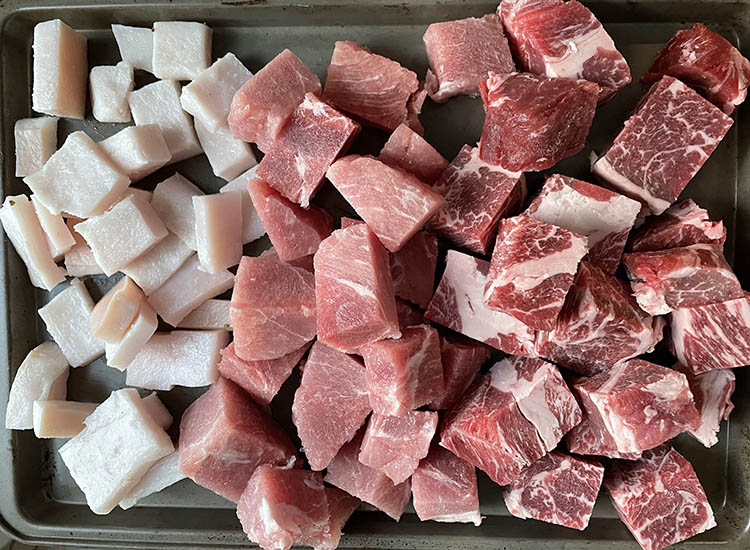
You will be adding fat to the grind as well. I used quality pork back fat, but quality beef brisket trimmings work just as well. These are sold in the meat section of some grocery stores, but not all. If you’re having a hard time finding back fat, call up your local butcher who can no doubt source some for you.
You can use all pork or all beef, but combining the two with the right ratio of fat adds another layer of flavor rather than using just one.
Hot dogs are a meat emulsion product. You’ll want to keep everything as cold as possible throughout the grinding process to be sure the proteins and fat emulsify properly and do not break apart due to heat.
Meat emulsions include sausages, bologna, franks, liver pâtés, and similar products. They are produced from finely homogenized meat where the proteins act as an emulsifier to the fat molecules, creating one homogenous product as a result of the grinding process.
Sharp grinder blades are also a necessity for a proper emulsification.
If you need a primer on grinding your own meat, we’ve got you covered.
How to make your own hot dogs
Follow the steps below to get started on making your own hot dogs.
1. Prep for meat grinding
Put the meat grinding parts into the freezer.

Cut the pork butt, beef chuck, and pork fat into 1-inch cubes, place on a tray, and into the freezer. You want the meat to parfreeze, not freeze all the way through. It should be slightly firm to the touch or have an internal temperature close to 32°F, but not below.
This usually takes 30 to 40 minutes.
2. Prepping the casings
To get that original hot dog size, you’ll use smaller casings than what you would use for sausage. You’ll need roughly six feet of casings for this recipe. I used ¾ inch sheep casings that will give the perfect size diameter for a hot dog.
Casings come packed in salt for longevity, so they require a good rinse before using. Rinse the outside with warm water until there’s no visible salt left. Open one end of the casing and rinse the inside until it comes out the other end. Once fully rinsed, place in a bowl of clean warm water to soak and become pliable.
3. Prepping the spices
Next, it’s time to mix the spices. Place the chopped garlic, mustard powder, chili powder, coriander, paprika, oregano, and black pepper into either a mortar and pestle, food processor, or spice grinder and pound or grind into an evenly colored paste.

4. Grind the meat
Set up the grinder with a large plate. Fill another large bowl with ice and place it under the grinder mouth. Place another large bowl on top of the ice to help keep everything cold.
Once cold, take the meat and back fat out of the freezer and mix it together in a large bowl.

Grind the meat and fat mixture through the large plate making sure the mixture is evenly distributed. Repeat this process. Grinding twice helps start meat emulsion and evenly distributes the ingredients.
Place the bowl of ground meat back in the freezer while you switch to the fine grinder plate.

Take the meat out of the freezer and grind the meat through the fine plate twice. If the mix starts to get warm, add a cup of crushed ice to it while it runs through the grinder. This will keep it cold and keep the fat from rendering. You don’t want the meat to reach 40°F.
After grinding the meat 4 times in total, it should be fully mixed and emulsified and look uniform in color and texture.

Add the spice paste you made earlier to the ground meat along with the remaining ingredients – milk powder, curing salt, coarse kosher salt, and sugar. Mix everything with a spatula or wooden spoon until fully incorporated.
You can use the paddle attachment of a stand mixer as well. Just be sure all the equipment has been chilled.
5. Stuff the casing
Set up your stuffer and put the meat in the hopper. If you’re stuffing with a grinder, you’ll need to put on the appropriate stuffing attachment and horn.

Get the horn wet and slide the casing on. You can grind directly onto a table or sheet pan, but make sure the surface is wet so that the casing doesn’t catch and tear.
Proceed to stuff the casing and link into 8” to 12” links – your preference.

Place the linked-up hot dogs on a sheet tray or baking sheet and place in the refrigerator to dry. They can be left overnight, but will be ready to smoke after two or three hours depending on the airflow in your fridge.
6. Smoke the hot dogs
We’ll be smoking the hot dogs low at first and increasing the temperature after one hour. You want the smoking temperature at 70°F – 80°F.
If you’re using a charcoal and wood smoker, this temperature is attainable using a small amount of fuel. It will take longer than usual to get to such a low temperature because you are using less initial charcoal, but keep it slow and steady so you don’t overshoot the target.
If you’re using a pellet grill, keep it on the lowest setting – usually the smoke setting. This will be higher than 80°F, so keep an eye on the hot dogs’ internal temperature.
Once you reach a steady temperature, put your smoking wood of choice on the coals. We used a combination of hickory and apple woods.
Keep the smoke flow steady throughout the cook, adding more wood chunks as needed.

After the first hour, the hot dogs will start to take on a light brown color. Increase the smoker temperature to 150°F and add wood if you need to.
After the next hour, check the temperature of one of the links. It should be between 140°F and 150°F and have a golden brown color.
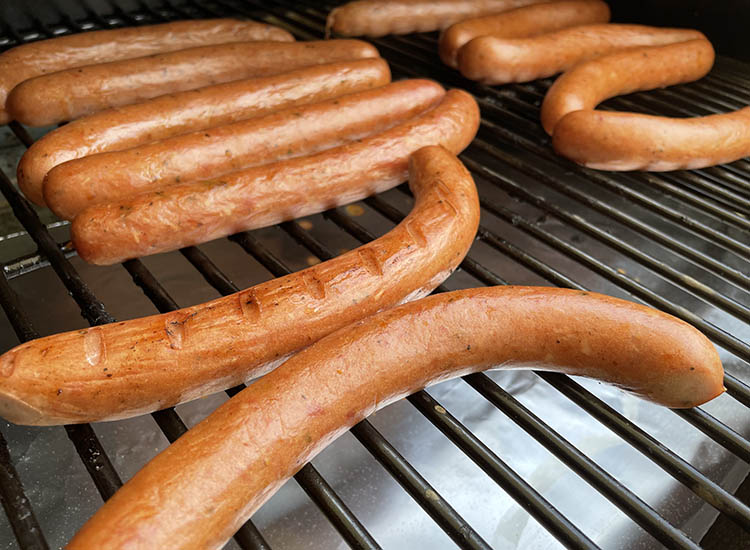
Continue cooking the links until internal temperatures reach 150°F throughout. Increase your smoker temperature if necessary and check every 15 minutes until the links reach 150°F.
Take the link with all the temperature probe pokes and give it a bite, relishing in its homemade glory. The first taste is reserved for the pitmaster and rightfully so after the hard work of hotdog making.

Take the dogs to the finish line with good-quality buns. I recommend a soft but stable bun like Martin’s Potato Rolls or a brioche-style bun. You didn’t come all this way to serve hot dogs on dry, crumbly buns. Top as you see fit and serve while warm.
If you want more homemade sausage recipes, try our breakfast sausage links.

Smoked Homemade Hot dogs
Ingredients
- 1 ¼ lbs pork butt cut into 1 inch cubes
- 1 lb beef chuck cut into 1 inch cubes
- 1 lb pork fatback cut into 1 inch cubes
- 6 ft natural sheep casings
- 1 tbsp garlic chopped
- ¾ tsp mustard powder
- 1 tsp chili powder
- 1 tsp ground coriander
- 1 tsp paprika
- ¾ tsp dried oregano
- 1 ½ tsp black pepper ground
- 2 tsp sugar
- 1 ½ tbsp sea salt fine
- ½ tsp curing salt #1
- ¼ cup milk powder
Instructions
- Put all parts of the meat grinder that you can into the freezer.
- Put the meat and fatback in the freezer for 30 – 40 minutes or until parfrozen.
- Rinse the casing thoroughly and then soak in a bowl of warm water untill needed.
- Place the chopped garlic, mustard powder, chilli powder, coriander, paprika, oregano and black pepper into a mortar and pestle and pound into a paste.
- Mix the chilled meat and fatback together in a large bowl.
- With the large die plate on the grinder, run the meat through twice.
- Put the mixture back in the freezer while switching to the small die plate.
- Remove the meat from the freezer and grind through the small plate twice.
- Add the spice paste, sugar, sea salt, curing salt and milk powder to the meat mixture and mix until fully incorporated and even in color.
- Fill the meat stuffer hopper with the mixture and stuff into the casing. Make links of desired length, 8” – 12” recommended.
- Put the links on a baking sheet or sheet tray and place in the refrigerator to dry, 2 hours to overnight.
- Preheat the smoker as low as it will go, 70°F – 80°F and add hickory and apple chunks.
- Smoke the hot dogs for one hour, adding more smoking wood as necessary.
- Increase smoker temperature to 150°F and continue smoking the hot dogs until the internal temperature reads 150°F, one to two more hours.
- Serve warm in a quality bun, top as desired.
Nutrition
Nutrition information is automatically calculated and should be used as an approximation only. If you’re worried you could always add a side of kale.



